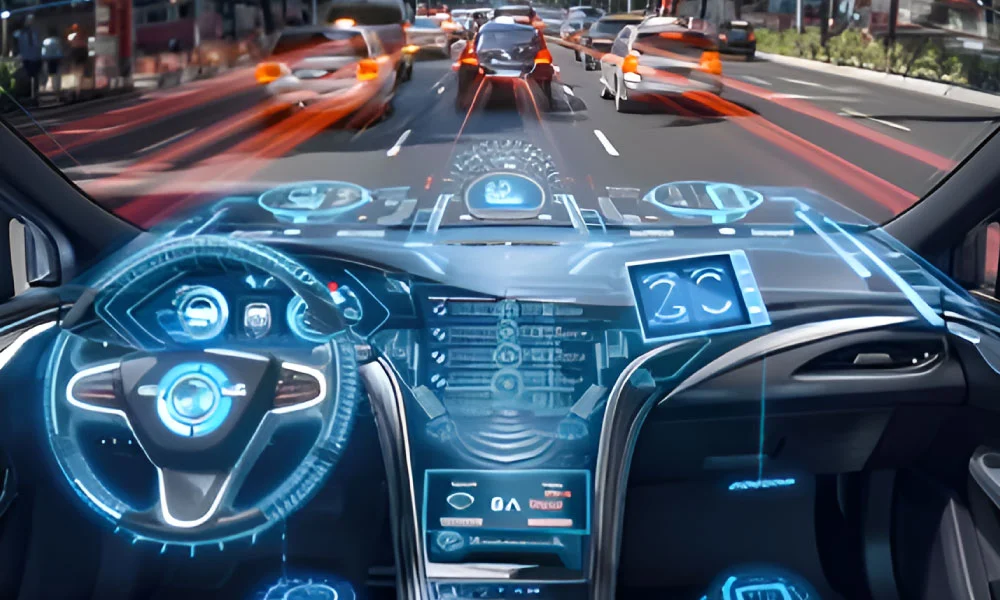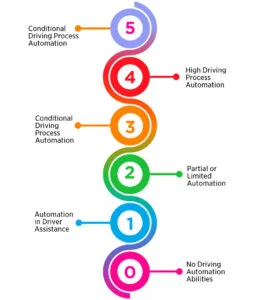Technological advancement has left its mark on every industry, including automobiles. Self-driving cars or autonomous vehicles are examples of technological excellence in the automobile sector. This innovation enables vehicles to operate without human intervention. There are six core levels of autonomous driving that determine the stages of automation in vehicles.
The concept of self-driving cars or autonomous vehicles is gradually gaining popularity across nations. In 2022, the worldwide autonomous vehicle industry recorded a valuation of $1.5 trillion and is about to go beyond $13 trillion by 2030. The equation shows how the domain is growing remarkably alongside continuous research and development.
This blog will explore the levels of autonomous driving, apart from understanding what self-driving is and how it works. Let’s begin...
What is Autonomous or Self-Driving?
Autonomous driving, also known as self-driving and driverless systems, is a concept in the automobile industry that signifies the ability of vehicles to function without human participation.
Vehicles with such capability largely utilize artificial intelligence (AI) and machine learning (ML) models to determine elements on the road and move forward accordingly. While executing the goal of making movements through traffic, self-driving vehicles gather large amounts of real-time data from geographic information mechanisms and sensors.
After gathering data, the mechanism processes it for the decision-making process and making movement accordingly. Autonomous driving technology also allows vehicles to find the fastest and the most convenient route. All users need to do is to put the destination that they want to reach.
How does Autonomous Driving Work?
Autonomous driving is a combination of the competencies of humans and AI, which requires faster network systems like 5G, vehicle networks, transportation servers, and others. Network connectivity, Sensors, AI, and compatible software are the core elements of self-driving vehicles.
Primarily, the mechanism uses sensors and creates an outline of the entire distance or route that a vehicle is going to cover. The following stage includes evaluating the details collected and sending them to the decision maker of the entire process, the actuators. It comprises critical algorithms and predictive modeling capabilities, based on which an autonomous vehicle controls its steering, braking, and speeding.
Such vehicles have several prototypes that are still in the development process. Currently, the deployment of partial and fully autonomous cars can be observed. These stages of automation in motor vehicles are also known as the levels of autonomous driving.
Six Levels of Autonomous Driving:
The levels of autonomous driving represent the degree of automation in a vehicle, denoting the requirement of human involvement. The first three levels seek complete human attention; however, the last three degrees require partial or no human control. Let us understand each level:
Level 0: No Driving Automation Abilities
At this level, vehicles have no autonomous capabilities and cannot function without the command of a human driver. Hence, driving seeks 100% human control here.
Level 1: Automation in Driver Assistance
Advancing one stage higher, at Level 1, vehicles have the ability to limitedly assist human drivers in their steering, speeding, and braking abilities. Here, automation looks after the cruise control of a vehicle, enabling smart suggestions to function effectively.
Level 2: Partial or Limited Automation
With the total involvement of the driver, vehicles at this stage can assist in steering, braking, and speeding. For this purpose and to enable continuous assistance, vehicles use ADAS or advanced driving assistance systems.
Level 3: Conditional Driving Process Automation
At this level, drivers can allow automation to take control wherever they identify the requirement. The mechanism accordingly can make decisions for movement. Nevertheless, this stage requires drivers to be in their position and ready to take vehicle control at any time.
Level 4: High Driving Process Automation
At this stage, automation is more efficient than level 3. Here, automation systems can take over vehicle control whenever needed without getting validation from the driver. Vehicles with high driving process automation can function within a particular distance and circumstance. Nevertheless, the driver can take charge at any time and drive the vehicle manually.
Level 5: Full Driving Process Automation
It is the most advanced stage among the levels of autonomous driving that includes no brakes, acceleration pedals, and steering, enabling fully autonomous functionality. Here, vehicles can run on automation in any situation and extreme conditions, requiring no human involvement, even in difficult circumstances.
Final Thoughts!
Within the levels of autonomous driving, vehicles in the initial three degrees are fully or partially available in the market. However, the following three degrees are not widespread in the industry yet.
The concept of self-driving vehicles requires high precision from each element involved. Moreover, an appropriate infrastructure is also needed where vehicles can easily access and use data for easy automation implementation.
Was the blog informative? If so, then find more such content here!
You May Also Like to Read:
5 Companies Providing Cognitive Automation Solutions
14 Best Cloud Infrastructure Automation Tools






